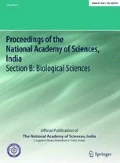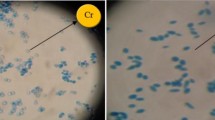Abstract
In the present investigation, an attempt has been made to screen and identify the isolates of yeast rich in mannan oligosaccharide (MOS) from different food sources collected from local market of Mumbai, India. Out of the forty-eight varied yeast strains obtained using selective and growth media, eighteen isolates were shortlisted on the basis of their MOS yield. The MOS yield obtained from Wickerhamomyces anomalus strain isolated from home-made dahi was even higher (33%) than that obtained from the traditionally used Saccharomyces cerevisiae strain (590.52 ± 8.25 vs 442.85 ± 4.25 mg/L). The reasonably good yield was found in Pichia casonil from grape juice (354.70 ± 1.02 mg/L) and Candida glabrata strain from carrot juice (350.8 ± 2.52 mg/L); however, the lowest yield was of Debaryomyces hansenii SZ10 (73.5 mg/L) grown on yogurt. Identification of the isolates was undertaken using Biomérieux VITEK® 2 system and molecular fingerprinting by polymerase chain reaction-random amplified polymorphism DNA (PCR-RAPD) using microsatellite M13 primer and polymerase chain reaction-restriction fragment length polymorphism (PCR-RFLP) of amplified 18S intergenic transcribed spacer region of ribosomal DNA (rDNA) after subjecting it to digest with three restriction endonucleases i.e. HaeIII, MspI and HinfI. Based on the better yield, it was concluded that W. anomalus can be exploited as an alternative of S. cerevisiae yeast stains for commercial mass scale MOS production for human food and animal feed industries in future.






Similar content being viewed by others
References
Transparency Market Research (2016) Global nutraceuticals market to reach US$278.96 bn by 2021 owing to increasing demand for nutritional diet. http://www.transparencymarketresearch.com/pressrelease/global-nutraceuticals-product-market.htm
Hays VW (1981) The Hays report: effectiveness of feed additive usage of antibacterial agents in swine and poultry production. Office of Technology Assessment, US Congress, Washington DC, and Rachelle Laboratories, Inc., Long Beach, CA
Kumar R, Mukherjee SC, Ranjan R, Nayak SK (2008) Enhanced innate immune parameters in Labeo rohita (Ham.) following oral administration of Bacillus subtilis. Fish Shellfish Immunol 24:168–172
Mirzapour-Rezaee SS, Farhangi M, Rafiee G (2016) Combined effects of dietary mannan- and fructo-oligosaccharide on growth indices, body composition, intestinal bacterial flora and digestive enzymes activity of regal peacock (Aulonocara stuartgranti). Aquac Nutr. doi:10.1111/anu.12430
Pourabedin M, Yang M, Zhao X (2017) Mannan- and xylooligosaccharides modulate caecal microbiota and expression of inflammatory-related cytokines and reduce caecal Salmonella Enteritidis colonisation in young chickens. FEMS Microbiol Ecol. doi:10.1093/femsec/fiw226
Badia R, Zanello G, Chevaleyre C, Lizardo R, Meurens F, Martínez F, Brufau J, Salmon H (2012) Effect of Saccharomyces cerevisiae var. Boulardii and β-galactomannan oligosaccharide on porcine intestinal epithelial and dendritic cells challenged in vitro with Escherichia coli F4 (K88). Vet Res 43:4–14
Padzorski RP, Gray GR, Nelson RD (1990) Different effects of native Candida albicans and mannan derived oligosaccharides on antigen-stimulated lymphoproliferation in vitro. J Immunol 144:707–716
Moran CA (2004) Functional components of the cell wall of Sacchromyces cerevisiae: applications for yeast glucan and mannan. In: Lyons TP, Jacques KA (eds) Nutritional biotechnology in the feed and food industries. Nottingham University Press, Nottingham, pp 283–296
Jones GH, Ballou CE (1969) Studies on the structure of yeast mannan. J Biol Chem 244:1043–1051
Kocourek J, Ballou CE (1969) Method for fingerprinting yeast cell mannans. J Bacteriol 100:1175–1181
Giovani G, Rosi I, Bertuccioli I (2012) Quantification and characterization of cell wall polysaccharides released by non-Saccharomyces yeast strains during alcohol fermentation. Int J Food Microbiol 160:113–118
Kurtzman CP, Fell JW (2006) Yeast systematics and phylogeny—implications of molecular identification methods for studies in ecology. Biodiversity and ecophysiology of yeasts, the yeast handbook. Springer, Berlin
Kurtzman CP, Piškur J (2006) Taxonomy and phylogenetic diversity among the yeasts. In: Sunnerhagen P, Piskur J (eds) Comparative genomics: using fungi as models. Springer, Berlin, pp 29–44
Hoffman CS, Wood V, Fantes PA (2015) An ancient yeast for young geneticists: a primer on the Schizosaccharomyces pombe. Model Syst Genet 201:403–423
Legras JL, Merdinoglu D, Cornuet JM, Karst F (2007) Bread, beer and wine: Saccharomyces cerevisiae diversity reflects human history. Mol Ecol 16(10):2091–2102
Barnett JA (2003) Beginnings of microbiology and biochemistry: the contribution of yeast research. Microbiol (Reading, Engl) 149(3):557–567
Vasdinyei R, Deak T (2003) Characterization of yeast isolates originating from Hungarian dairy products using traditional and molecular identification techniques. Int J Food Microbiol 86:123–130
Tornai-Lehoczki J, Dlauchy D (2000) Elimination of brewing yeast strains using different molecular techniques. Int J Food Microbiol 62:37–45
Schuller D, Valero E, Dequin S, Casal M (2004) Survey of molecular methods for typing wine yeast strains. FEMS Microbiol Lett 231:19–26
Senses-Ergul S, Agoston R, Belak A, Deak T (2006) Characterization of some yeast isolates from foods by traditional and molecular tests. Int J Food Microbiol 108:120–124
Peat S, Whelan WJ, Edwards TE (1961) Polysaccharides of baker’s yeast. Part IV. Mannan. J Chem Soc 1:29–34
Nakajima T, Ballou CE (1974) Characterization of the carbohydrate fragments obtained from Saccharomyces cerevisiae mannan by alkaline degradation. J Biol Chem 249:7679–7684
Dubois M, Gill KA, Hamilton JK, Rebers PA, Smith F (1958) Colorimetric method for determination of sugar and related substances. J Anal Chem 28:350–356
Hoffman CS, Winston F (1987) A ten-minute DNA preparation from yeast efficiently released autonomous plasmids for transformation of Escherichia coli. Gene 57:267–272
Huey B, Hall J (1989) Hypervariable DNA fingerprinting in Escherichia coli Minisatellite probe from bacteriophage M13. J Bacteriol 171:2528–2532
James SA, Collins MD, Roberts IN (1994) Genetic interrelationship among species of the genus Zygosaccharomyces as revealed by small subunit rRNA gene sequences. Yeast 10:871–881
Nunez F, Rodríguez MM, Córdoba JJ, Bermúdez ME, Asensio MA (1996) Yeast population during ripening of dry-cured Iberian ham. Int J Food Microbiol 29:271–280
Sonia GB, Gowda T, Ramu G (2016) A modified method for extraction and deproteinization of mannan oligosaccharides. World J Pharm Sci 4:52–54
Agarwal S, Manchanda V, Verma V (2011) Yeast identification in routine clinical microbiology laboratory and its clinical relevance. Indian J Med Microbiol 29:172–177
Fenn JP, Segal H, Barland B (1994) Comparison of updated Vitak yeast biochemical card and ALI 20C yeast identification system. J Clin Micriobiol 32:1184–1187
Zhang L, Xiao M, Wang H, Gao R, Fan X, Brown M, Gray TJ, Kong F, Xu FC (2014) Yeast identification algorithm based on use of the Vitek MS system selectively supplemented with ribosomal DNA sequencing: proposal of a reference assay for Invasive Fungal Surveillance Programs in China. J Clin Microbiol 52:572–577
Loureiro V, Querol A (1999) The prevalence and control of spoilage yeasts in foods and beverages. Trends Food Sci Technol 10:356–365
Capece A, Salzano G, Romano P (2003) Molecular typing techniques as a tool to differentiate non-Saccharomyces wine species. Int J Food Microbiol 84:33–39
Andrade MJ, Redriguez M, Sanchez B, Aranda E, Cordoba JJ (2006) DNA typing methods for differentiation of years related to dry-cured meat products. Int J Food Microbiol 107:48–58
McCullough MJ, Clemons KV, McCusker JH, Stevens DA (1998) Intergenic transcribed spacer PCR ribotyping for differentiation of Saccharomyces species and its specific hybrids. J Clin Microbiol 36:1035–1038
Mozina SS, Dlauchy D, Deak T, Respor D (1997) Identification of Saccharomyces sensustricto and Torulaspora yeasts by PCR ribotyping. Lett Appl Microbiol 24:311–315
Andrighetto R, Psomas E, Tzanetakis N, Suzzi G, Lombardi A (2000) Randomly amplified polymorphic DNA (RAPD) PCR for the identification of yeast isolated from dairy products. Lett Appl Microbiol 30:5–9
Acknowledgements
The authors are grateful to Dr. Gopal Krishna, Director/Vice-Chancellor, ICAR-Central Institute of Fisheries Education, Mumbai, India for providing support and necessary facilities for carrying out this experiment. S.G. is thankful to Dr. K.N. Ghorude, Principal, Vartak College, Vasai West, Dist Phalghar, India for granting kind permission to pursue degree under in-service Ph.D. program of Mumbai University, Mumbai, India.
Author information
Authors and Affiliations
Corresponding author
Ethics declarations
Conflict of interest
The authors declare that they have no conflict of interest.
Rights and permissions
About this article
Cite this article
Gupta, S., Bhathena, Z.P., Kumar, S. et al. Quantification and Characterization of Mannan Oligosaccharide Producing Yeasts isolated from Various Food Products. Proc. Natl. Acad. Sci., India, Sect. B Biol. Sci. 88, 1237–1247 (2018). https://doi.org/10.1007/s40011-017-0859-7
Received:
Revised:
Accepted:
Published:
Issue Date:
DOI: https://doi.org/10.1007/s40011-017-0859-7




